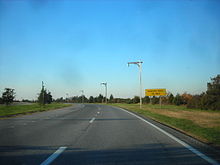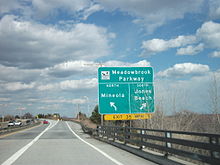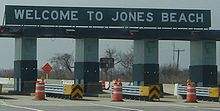
Robert Moses was an American urban planner and public official who worked in the New York metropolitan area during the early to mid-20th century. Moses is regarded as one of the most powerful and influential people in the history of New York City and New York State. The grand scale of his infrastructure projects and his philosophy of urban development influenced a generation of engineers, architects, and urban planners across the United States.

Jones Beach State Park is a state park in the U.S. state of New York. It is located in southern Nassau County on Jones Beach Island, a barrier island linked to Long Island by the Meadowbrook State Parkway, Wantagh State Parkway, and Ocean Parkway. The park was created during Robert Moses' administration as President of the Long Island State Park Commission as part of the development of parkways on Long Island.
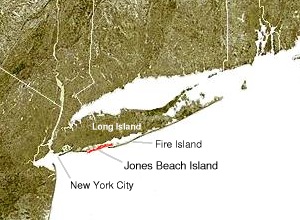
Jones Beach Island is one of the outer barrier islands off the southern coast of Long Island in the U.S. state of New York.

The Robert Moses Causeway is an 8.10-mile (13.04 km) state parkway in Suffolk County, New York on Long Island. It is named for the master builder and urban planner Robert Moses. The parkway, originally known as the Captree Causeway, connects West Islip on Long Island to the barrier beach islands, such as Captree Island, Jones Beach Island, and the western tip of Fire Island, to the south. It is designated New York State Route 908J (NY 908J), an unsigned reference route.
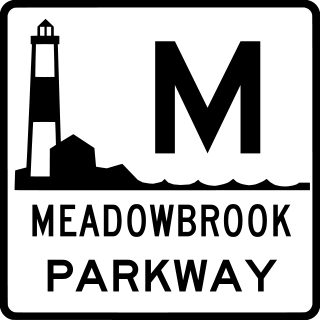
The Meadowbrook State Parkway is a 12.52-mile (20.15 km) controlled-access parkway in Nassau County, New York, in the United States. Its southern terminus is at a full cloverleaf interchange with the Bay and Ocean parkways in Jones Beach State Park. The parkway heads north, crossing South Oyster Bay and intersecting Loop Parkway before crossing onto the mainland and connecting to the Southern State Parkway in North Merrick. It continues north to the hamlet of Carle Place, where the Meadowbrook Parkway ends at exit 31A of the Northern State Parkway. The Meadowbrook Parkway is designated New York State Route 908E (NY 908E), an unsigned reference route. Most of the road is limited to non-commercial traffic, like most parkways in the state of New York; however, the portion south of Merrick Road is open to commercial traffic.
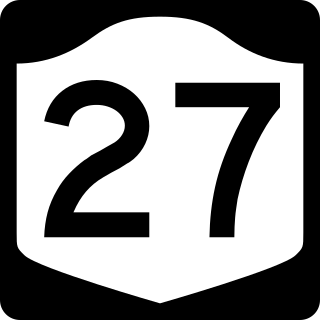
New York State Route 27 (NY 27) is a 120.58-mile (194.05 km) long state highway that runs east–west from Interstate 278 (I-278) in the New York City borough of Brooklyn to Montauk Point State Park on Long Island, New York. Its two most prominent components are Sunrise Highway and Montauk Highway, the latter of which includes the Montauk Point State Parkway. NY 27 acts as the primary east–west highway on southern Long Island east of the interchange with the Heckscher State Parkway in Islip Terrace. The entire route in Suffolk, Nassau, and Queens counties were designated by the New York State Senate as the POW/MIA Memorial Highway. The highway gives access to every town on the South Shore. NY 27 is the easternmost state route in the state of New York, as well as the longest highway on Long Island.
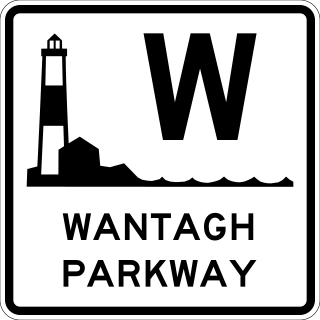
The Wantagh State Parkway is a 13.33-mile (21 km) controlled-access parkway on Long Island, New York, in the United States. It links the Ocean Parkway in Jones Beach State Park with the Northern State Parkway in Westbury. The parkway is located approximately 30 miles (48 km) east of Manhattan and 14 miles (23 km) east of the Nassau–Queens border.

The Southern State Parkway is a 25.53-mile (41.09 km) controlled-access parkway on Long Island, New York, in the United States. The parkway begins at an interchange with the Belt and Cross Island parkways in Elmont, in Nassau County, and travels east to an interchange with the Sagtikos State Parkway in West Islip, Suffolk County, where it becomes the Heckscher State Parkway. The Southern State Parkway comprises the western portion of unsigned New York State Route 908M (NY 908M), with the Heckscher Parkway occupying the eastern section.

The Northern State Parkway is a 28.88-mile (46.48 km) controlled-access parkway on Long Island in the U.S. state of New York. The western terminus is at the Queens–Nassau County line in Lake Success – west of which the parkway continues westward into New York City as the Grand Central Parkway. The eastern terminus is at New York State Route 347 (NY 347) and NY 454 in Hauppauge, in Suffolk County. As its name implies, the parkway services communities along the northern half of the island. The parkway is designated New York State Route 908G (NY 908G) – an unsigned reference route – and has been ceremoniously named Purple Heart Way since 2011.

The Ocean Parkway is a 15.59-mile (25.09 km) limited-access parkway that traverses Jones Beach Island between Jones Beach State Park and Captree State Park on Long Island, New York, United States. It begins at the southern terminus of the Meadowbrook State Parkway and heads east across Jones Beach Island, intersecting the south end of the Wantagh State Parkway before ending just past the southern terminus of the Robert Moses Causeway.
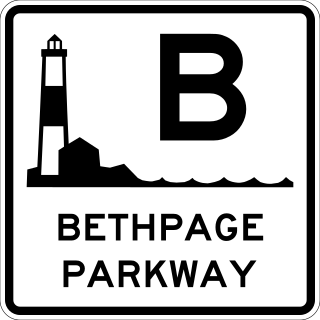
The Bethpage State Parkway is a 2.49-mile (4.01 km) controlled-access parkway in Nassau County on Long Island, New York, in the United States. It begins at a trumpet interchange with the Southern State Parkway in North Massapequa and serves Boundary Avenue, NY 24, and Central Avenue before terminating at a traffic circle with Plainview Road and a local park road in Bethpage State Park. The parkway is designated as New York State Route 907E (NY 907E), an unsigned reference route. It is also ceremoniously designated as the Philip B. Healey Memorial Parkway for Assemblyman Philip B. Healey (1921–1996).

The Heckscher State Parkway is an 8.24-mile (13.26 km) controlled-access parkway on Long Island, New York, in the United States. The parkway is located entirely within the Suffolk County town of Islip. Although it officially begins at the south end of the Sagtikos State Parkway in West Islip, it remains signed as the Southern State Parkway until it intersects with NY 27 in Islip Terrace. The section signed as the Southern State Parkway proceeds east as a six-lane parkway through Brentwood and Central Islip, loosely paralleling New York State Route 27 (NY 27). At Islip Terrace, the Heckscher Parkway turns southward, crossing NY 27 where it becomes signed as the Heckscher State Parkway. The parkway comprises the eastern portion of New York State Route 908M (NY 908M), an unsigned reference route, with the Southern State Parkway occupying the western section. In order to avoid confusion, the parkway is signed as an extension of the Southern State Parkway west of the NY 27 interchange.
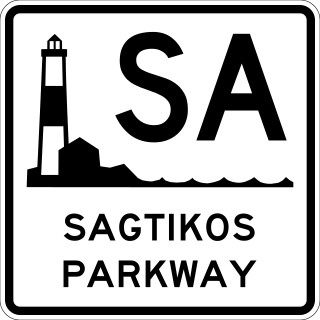
The Sagtikos State Parkway is a 5.14-mile (8.27 km) controlled-access parkway in Suffolk County on Long Island, New York, in the United States. It begins at an interchange with the Southern State and Heckscher Parkways in the hamlet of West Islip and goes north to a large cloverleaf interchange with the Northern State Parkway in the Town of Smithtown, where the Sagtikos ends and the road becomes the Sunken Meadow State Parkway. The parkway comprises the southern half of New York State Route 908K (NY 908K), an unsigned reference route, with the Sunken Meadow State Parkway forming the northern portion.

The Sunken Meadow State Parkway is a 6.19-mile (9.96 km) controlled-access parkway in Suffolk County, on Long Island, New York.
The Bay Parkway is a 3.26-mile (5.25 km) limited-access parkway entirely within Jones Beach State Park in Nassau County, New York, in the United States. The western terminus is at a loop near the western edge of Jones Inlet. The eastern terminus is at the Jones Beach Amphitheater east of an interchange with the Wantagh State Parkway. The parkway is primarily a service road for the park, providing access to the boat basin, fishing piers, and many of the parking lots along the beach. However, the parkway also has an interchange with the Meadowbrook State Parkway and Ocean Parkway.

The Outer Barrier, also known as the Long Island and New York City barrier islands, refers to the string of barrier islands that divide the lagoons south of Long Island, New York from the Atlantic Ocean. These islands include Long Beach Barrier Island, Barnum Island, Jones Beach Island, Fire Island and Westhampton Island. The outer barrier extends 75 miles (121 km) along the South Shore of Long Island, from the Rockaway Peninsula in New York City to the east end of Shinnecock Bay in Suffolk County.

The majority of parkways in the US state of New York are part of a statewide parkway system owned by several public and private agencies but mostly maintained by the New York State Department of Transportation (NYSDOT). A handful of other roads in the Hudson Valley and on Long Island are also known as parkways but are not part of the state system. The roads of the state parkway system were among the first expressways to be constructed. These highways were not divided and allowed no driveway cuts, but did have intersections for some of the streets they crossed. A small section of the privately financed Long Island Motor Parkway was the first expressway to begin operation as a toll road and the first highway to use bridges and overpasses to eliminate intersections.
The Long Island State Park Commission, also known as LISPC, is a government agency on Long Island, in the state of New York, headquartered at Belmont Lake State Park in North Babylon. Originally a standalone agency, it is now a regional subdivision of the New York State Office of Parks, Recreation, and Historic Preservation.

The Jones Beach State Park, Causeway and Parkway System is a national historic district located in Nassau County, New York, United States.
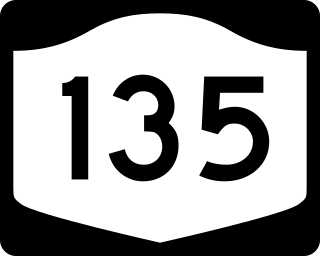
New York State Route 135 (NY 135) is a 10.8-mile (17.4 km) freeway in eastern Nassau County, New York, in the United States. The route connects Seaford with Syosset. The highway runs from Merrick Road in Seaford to NY 25 in Syosset. In between, NY 135 passes through Bethpage and Plainview and serves Bethpage State Park. The highway is ceremoniously designated as the Ralph J. Marino Expressway; however, it is more commonly known as the Seaford–Oyster Bay Expressway.


